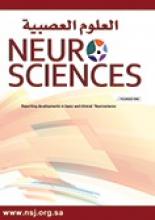Article Figures & Data
Tables
- Table 1
Knowledge of stroke, site, types and risk factors among the study sample of primary healthcare attendants in Abha, Southwestern Saudi Arabia (n=1472).
Knowledge Proper knowledge n (%) Site Brain 1285 (87.3) Types Thrombosis 936 (63.6) Hemorrhage 643 (43.7) Risk factors Stress and anxiety 428 (29.1) Hypertension 821 (55.8) Dyslipidemia 674 (45.8) Smoking 616 (41.8) Diabetes mellitus 513 (34.9) Obesity 508 (34.5) Sedentary life 400 (27.2) Aging 539 (36.6) Family tendency 172 (11.7) Number of correctly identified risk factors Less than 2 risk factors 313 (21.3) 2-4 risk factors 835 (56.7) More than 4 risk factors 324 (22.0) - Table 2
Knowledge of stroke symptoms, outcomes and responses to an attack among the study sample of primary healthcare attendants in Abha city, Southwestern Saudi Arabia (n=1472).
Knowledge Proper Knowledge No. (%) n (%) Symptoms Dizziness 750 (51.0) Sudden severe headache 796 (54.1) Sudden confusion 263 (17.9) Disturbed vision 460 (31.3) Difficulty speaking 657 (44.6) Difficulty walking 228 (15.5) One side paralysis 518 (35.2) Face paralysis 289 (19.6) One side numbness 412 (28.0) Number of correctly identified symptoms Less than 2 symptoms 347 (23.6) 2 - 4 symptoms 856 (58.2) More than 4 symptoms 269 (18.3) Response to attack Inform a family members and neighbors 515 (35.0) Contact a doctor 1075 (73.0) Go to the hospital 989 (67.2) Call an ambulance 772 (52.4) Improper response (Ignore/self-prescribed medication) 277 (18.8) Outcomes Paralysis 803 (54.6) Speech problem 491 (33.4) Walking problem 476 (32.3) Visual problem 361 (24.5) Hearing problem 276 (18.8) Psychological problem 243 (16.5) Death 931 (63.2) - Table 3
Uni-variate and multivariate analysis of potential determinants of insufficient knowledge of stroke symptoms (knowledge less than 2 symptoms) among the study sample of primary healthcare attendants in Abha, Southwestern Saudi Arabia (n=1472).
Variables Knowledge of symptoms Uni-variate cOR (95%CI) Multivariate aOR (95%CI) Sufficient Insufficient n (%) Gender Male 755 (67.1) 236 (68.0) - 0.96 (0.74-1.26) Female 370 (32.9) 111 (32.0) 0.96 (0.74-1.24) Education <secondary 181 (16.1) 62 (17.9) - 0.92 (0.64-1.33) ≥secondary 944 (83.9) 285 (82.1) 0.88 (0.64-1.21) Age (years) <40 790 (70.2) 257 (74.1) - 0.86 (0.62-1.20) ≥40 335 (29.8) 90 (25.9) 0.83 (0.63-1.08) Marital status Single 470 (41.8) 156 (45.0) - 0.97(0.74-1.28) Married 655 (58.2) 191 (55.0) 0.88 (0.69-1.12) Sources of knowledge* Media* 685 (60.9) 173 (49.9) 0.64 (0.50-0.81) 0.43 (0.32-0.59)** Physician and nurses* 253 (22.5) 50 (14.4) 0.58 (0.42-0.81) 0.46 (0.32-0.66)** Friends and relatives* 514 (45.7) 113 (32.6) 0.57 (0.45-0.74) 0.40 (0.29-0.55)** - Table 4
Uni-variate and multivariate analysis of potential determinants of insufficient knowledge of stroke risk factors (knowledge less than 2 risk factors) among the study sample of primary healthcare attendants in Abha, Southwestern Saudi Arabia (n=1472).
Variables Knowledge of symptoms Uni-variate cOR (95%CI) Multivariate aOR (95%CI) Sufficient Insufficient n (%) Gender Male 788 (68.0) 203 (64.9) - 1.25 (0.94-1.65) Female 371 (32.0 110 (35.1) 1.15 (0.88-1.50) Education <secondary 195 (16.8) 48 (15.3) - 1.37 (0.92-2.06) ≥secondary 964 (83.2) 265 (84.7) 1.12 (0.79-1.57) Age (years) <40 812 (70.1) 235 (75.1) - 0.94 (0.66-1.34) ≥40 347 (29.9) 78 (24.9) 0.78 (0.58-1.03) Marital status Single 481 (41.5) 145 (46.3) - 0.89 (0.67-1.18) Married 678 (58.5) 168 (53.7) 0.82 (0.64-1.05) Sources of knowledge* Media* 719 (62.0) 139 (44.4) 0.49 (0.38-0.63) 0.28 (0.20-0.39)** Physician and nurses* 260 (22.4) 43 (13.7) 0.55 (0.39-0.78) 0.38 (0.26-0.57)** Friends and relatives* 524 (45.2) 103 (32.9) 0.59 (0.45-0.77) 0.35 (0.25-0.49)** - Table 5
Uni-variate and multivariate analysis of potential determinants of insufficient knowledge of proper response to stroke attack among the study sample of primary healthcare attendants in Abha, Southwestern Saudi Arabia (n=1472).
Variables Knowledge of proper response Uni-variate COR (95%CI) Multivariate AOR (95%CI) Yes No n (%) Gender Male 831 (69.5) 160 (57.8) - 1.70 (1.29-2.25)** Female 364 (30.5) 117 (42.2) 1.67 (1.27-2.18) Education <secondary 185 (15.5) 58 (20.9) - 0.94 (0.64-1.38) ≥secondary 1010 (84.5) 219 (79.1) 0.69 (0.49-0.96) Age (years) <40 885 (74.1) 162 (58.5) - 1.84 (1.32-2.55)** ≥40 310 (25.9) 115 (41.5) 2.03 (1.54-2.66) Marital status Single 537 (44.9) 89 (32.1) - 1.36 (1.01-1.85)** Married 658 (55.1) 188 (67.9) 1.72 (1.30-2.27) Sources of knowledge* Media* 678 (56.7) 180 (65.0) 1.41 (01.08-1.86) 1.95 (1.43-2.67)** Physician and nurses* 224 (18.7) 79 (28.5) 1.73 (1.28 -2.33) 1.88 (1.38-2.57)** Friends and relatives* 500 (41.8) 127 (45.8) 1.17 (0.90- 1.53) 1.54 (1.15-2.06)**






